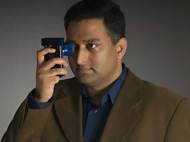CATRA – a new affordable technology for cataract diagnose
 Cataracts are the leading cause of blindness worldwide, with over 48% of world blindness caused by age related cataracts. Existing diagnostic methods require Slit-lamps, which require a trained physician to interpret the results and aren’t affordable. Researchers from MIT have developed a simple device that can clip onto an ordinary smartphone or a tablet and provide a diagnosis of cataracts within a few minutes, making it accessible in the developing areas of the world.
Cataracts are the leading cause of blindness worldwide, with over 48% of world blindness caused by age related cataracts. Existing diagnostic methods require Slit-lamps, which require a trained physician to interpret the results and aren’t affordable. Researchers from MIT have developed a simple device that can clip onto an ordinary smartphone or a tablet and provide a diagnosis of cataracts within a few minutes, making it accessible in the developing areas of the world.
Dubbed CATRA, the device sweeps a beam of light across the eye to detect cataracts. Unlike the standard test for cataracts in an ophthalmologist’s office which grades the stadium of development from 1 to 4 (ranging from no cataracts to completely blocked vision), the new test actually provides much more information. After it scans the lens of the eye, it creates a map showing position, size, shape and density of cataracts.
Although it is more precise than doctors need, at some point in the future new cataract therapies may treat specific areas of cloudiness, rather than removing the whole lens. In meantime, CATRA could provide great value as a simple and low-cost way of making the initial diagnosis that cataracts are present, especially in parts of the developing world where such services are now rare and often require travel to distant cities.
In addition, the new device may be able to detect cataracts at an earlier stage than existing tests, because it can pick up changes in parts of the lens that have not yet become opaque. The current testing technology relies on light reflected back by the lens, to be seen by the doctor performing the test, while CATRA relies on light passing through the lens as reported by the patient, who just has to indicate whether a point of light remains steady, dims or disappears.
As the device scans a beam of light across the eye, it uses rays that are perfectly aligned so that the eye’s lens focuses all the beams to the same point on the fovea, the area of the retina where it has maximum resolution. So even though the beam is moving, to the patient it appears as a single stationary point, which sometimes blurs or disappears if cataracts are present.
In preliminary testing with 22 subjects, CATRA discovered cataracts in one previously undiagnosed subject who’d had an eye test in a doctor’s office a few months prior. The detection was later confirmed in a follow-up test using standard methods.
The new screening tool will be presented at the annual computer-graphics conference SIGGRAPH, being held Aug. 7-11 in Vancouver. The new work is a follow-up to the team’s earlier development of a system called NETRA – a system that uses a smartphone with a different clip-on attachment to measure refractive errors of the eye.
For more information about CATRA, you can read the paper named: “CATRA: Interactive Measuring and Modeling of Cataracts” (PDF).









This could be really helpful in developing countries.
I just find out 3 days ago that I have cataract in my right Eye
Walk up on the 24 in the morning and my right Eye feel like have some shades shapes and feel uncontainable.
So went and visit Eye Dr. He said you start have cataract and not bad?
So my question how long I have before I should do something for need your advise please
Thank you
Ray Ghadba
Hello Ray,
It all depends on the situation and how much it is affecting your life (driving at night, job, hobby, reading…) as well. If I understood your doctor told it’s not bad yet, so surgery is not needed yet.
It is best to check advice at couple of doctors and ask around well before undergoing surgery (both should you do it and where to do it). It is up to you with final decision :)